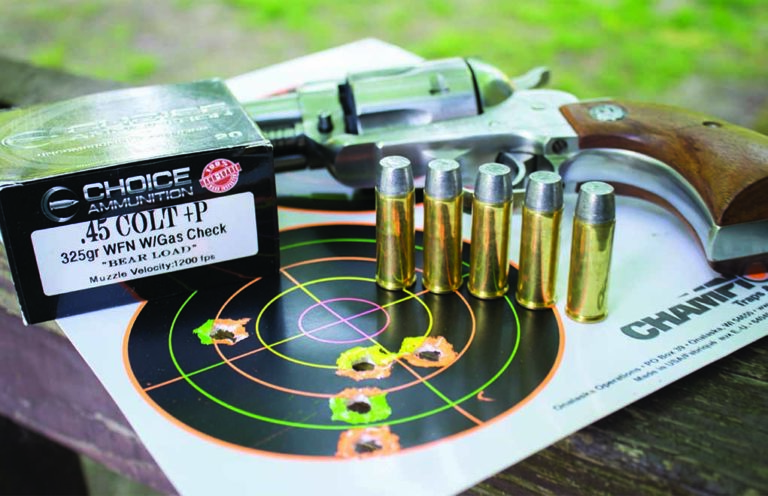
Among the most famous of all handgun cartridges, the .45 Long Colt has proven unsinkable. Versatile as it is historic, there's little wonder why.
I’d received the good news that my New York State pistol permit had been approved by the powers that be, and I doubt a chisel would’ve removed the grin from my face. I then proceeded to set about choosing what would be my first handgun.
It was a topic my father and I’d discussed at some length, and “Ol’ Grumpy Pants” had imparted his wisdom: “Buy a snub-nosed Smith & Wesson .38 Special; you’re gonna carry it a whole lot more than you’re gonna shoot it.”
While he wasn’t entirely wrong, and a Model 36 S&W—which was identical to his (with the exception of the beefier Pachmayr grips)—would come later, I had a different path in mind.
First of all, I’m a hunter. Second of all, I wanted something fully capable of taking deer, bear and other big game; and I also wanted something classic at the same time. I knew it’d be a wheelgun—and a strong, modern action at that, while paying homage to the time-honored designs. I settled on a stainless Ruger Blackhawk, chambered in .45 Long Colt and with the 7½-inch barrel.
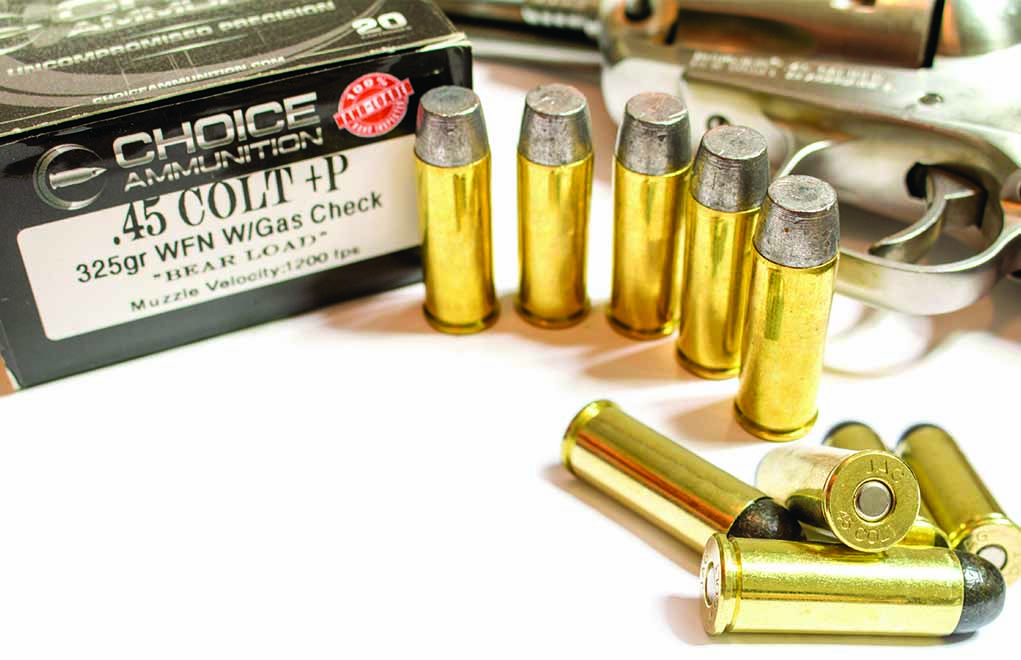
The gun could handle any .45 Colt ammunition on the market, because its design is much stronger than the traditional Colt Single Action Army pistols. However, it has the clean lines of a classic six-shooter. The longer barrel, while a challenge to carry and nearly impossible to conceal, certainly wrings every last bit of velocity out of any load but also makes it easier to hit distant targets. The beauty of the .45 Colt is that it has many faces. It’s a pleasure to shoot, with the mild loads mimicking the original 1873 formula and the modern developments, which inspired the larger .454 Casull.
It’s been a movie title, a television series, a major league baseball team name and (although there’s some speculation about the possible tie-in with an NFL runningback), a malt liquor. It‘s served the U.S. Army, laid bad hombres down for good in the hands of sheriffs, deputies and marshals, and has been used by the outlaws as well. The .45 Colt, along with the .44-40 WCF, embodies the Old West: The .45 Long Colt is the OK Corral; it’s “Bat Masterson” and “Butch Cassidy.” But, most importantly, the .45 Colt is, was and always shall be … cool.
It was developed as a joint effort between Colt and the Union Metallic Cartridge Company, beginning in 1871 and concluding in 1872. The cartridge and the Colt Single Action Army six-shot revolver were soon accepted by the U.S. Army and would serve from that date until 1892.
(And, just for the record, the first Colt Single Action Army—bearing serial number 1—was found in a barn in New Hampshire in the early 1900s; and yes, it was chambered for the .45 Colt.)
The design of the cartridge was simple: a rimmed case measuring 1.285 inches in length with a rim of 0.512 inch and maintaining a cartridge overall length of 1.58 inches. It was loaded with (roughly) 40 grains of fine black powder under a 255-grain lead bullet, moving at slightly more than 875 fps. For its time, this was a formidable load, and its performance was unmatched.
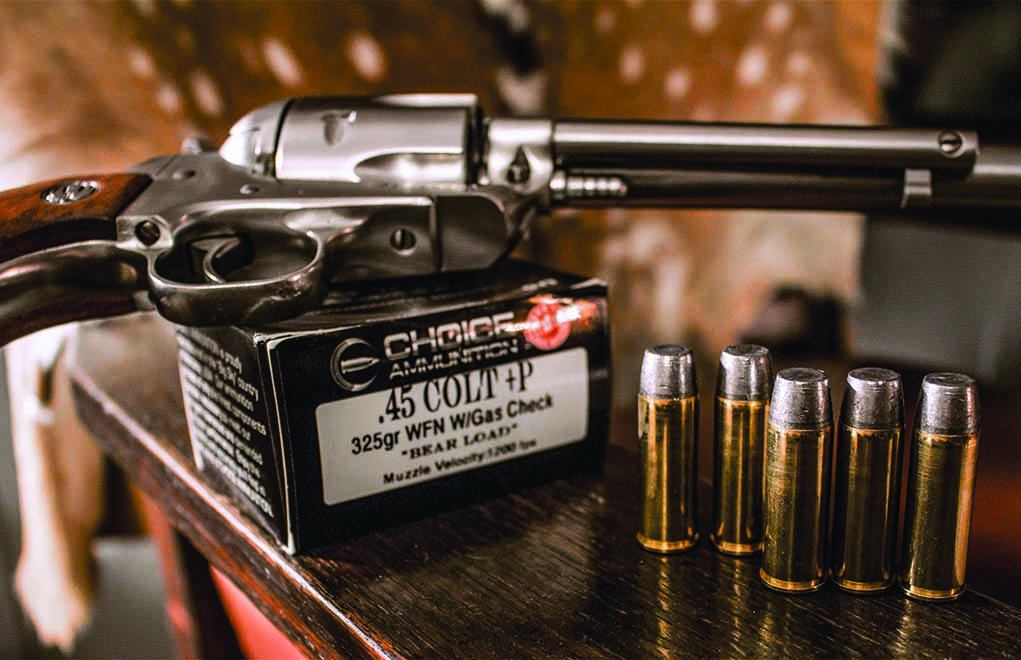
Although it was replaced by the .38 Long Colt in 1892 as the U.S. Army’s official sidearm, the miserable performance of that combination in the Philippine-American conflict forced the powers that be to rethink their choice. The Moro juramentados—frenzied Moro warriors—would take several shots from the .38 Long Colt without being stopped. This simply wasn’t the case with the .45 Colt, and so it was revived for a brief time … until John Browning’s .45 ACP in the M1911 won the contract for the new service sidearm and completely changed the idea of what a soldier’s sidearm should be.
More On The .45 Colt And Its Guns:
- The .45 Colt: A Wheelgun Classic
- Hot-Rodding the .45 Colt
- Ruger Bisley: Battle Of .45 Colt And .44 Mag Custom Builds
- Colt Single-Action Army: Owning The Enduring Legend
What’s in a Name?
“.45 Long Colt.”
It can instigate an argument in the blink of an eye, and it’s as aggravating to those who study the history and development of cartridges as it is when I show someone a photo of a Cape buffalo from Africa and they respond, “Nice water buffalo!”
Consulting the list of SAAMI-approved cartridges, the official cartridge designation is “45 Colt” (we can argue about the decimal point later)—excluding the word, “Long.” There are those who believe the “Long” was added to differentiate the Colt cartridge from the shorter .45 Schofield or .45 Smith & Wesson.
Others insist the designation was brought over from the .38 Short Colt and .38 Long Colt pair: Just as the .38 Short Colt can be fired in the chamber of the .38 Long Colt (and both can be fired in the modern .38 Special chamber), the .45 Schofield can be fired in the chamber of the .45 Long Colt.
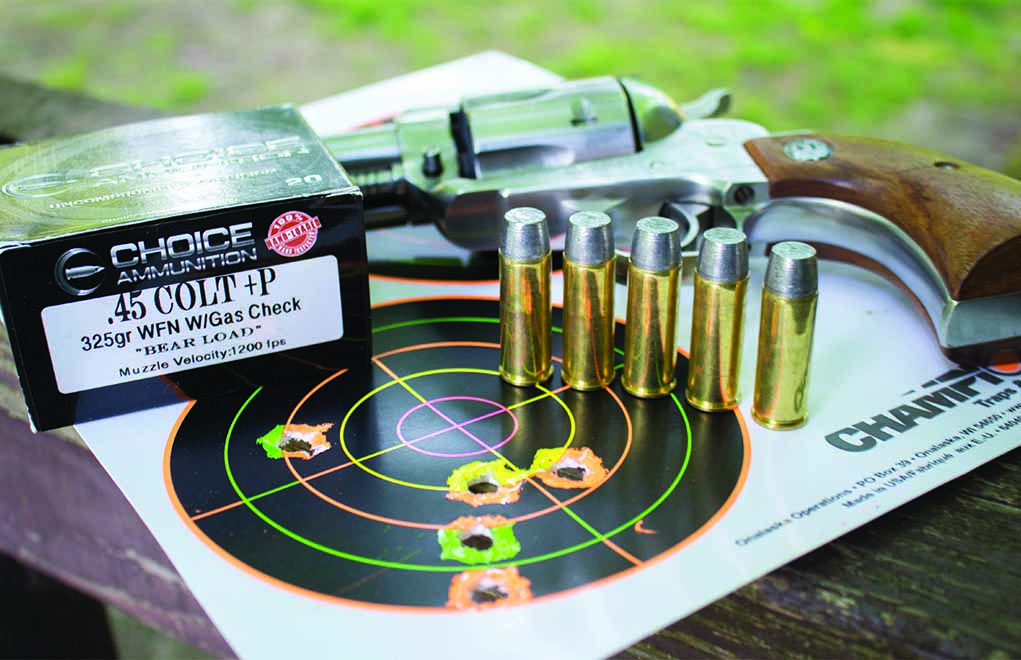
Regardless, the proper name for the cartridge is “.45 Colt,” which is completely different from the rimless .45 ACP (Automatic Colt Pistol). And that’s that.
From Lamb to Lion
The .45 Colt of 1873 is not the modern .45 Colt; the modern handguns can handle pressures far greater than the older Single Action Army design can.
My Ruger Blackhawk is one of the strongest designs out there, but there are others, such as the Freedom Arms Model 83, Ruger Redhawk and T/C Encore. However, those Colt Single Action Army revolvers and the clones—the Ruger Vaqueros and similar guns from Cimarron and Uberti—need to be held to a lower pressure limit, along the lines of the original ballistic formula.
Much as Elmer Keith, who had a healthy respect for the .45 Colt, experimented with the .44 Special cartridge to arrive at what would become the .44 Remington Magnum of “Dirty Harry” fame, Dick Casull used the .45 Colt cartridge to develop his .454 Casull. And while there’s no denying that the .454 Casull is a raging beast of a handgun cartridge (the Casull is simply an elongated .45 Colt at higher velocities), the high-pressure .45 Colt loads have no flies on them.
I’ve developed several handloads based on the 250- and 300-grain Hornady XTP Mag bullets. Should you want something a bit beefier, there are the Swift A-Frame Heavy Revolver projectiles and the Barnes XPB projectiles.

The .45 Colt wears many hats, in that the simple, 255-grain lead bullets at 1873 velocities are as effective as they were nearly 150 years ago. But, in the proper handgun—or even a lever-action rifle—the heavier bullets at higher pressures are certainly a step above the Old West power level. The stronger actions can see a 300-grain bullet pushed to more than 1,200 fps, which is both hard hitting and hard kicking.
My Ruger Blackhawk isn’t particularly finicky. With its 7½-inch barrel, I feel I’m good to hunt out to 50 yards with open sights. I like the wide variety of loads available, and a trio of loads from Choice Ammunition highlights the capabilities of the .45 Colt very well; I use all three.
The Choice Cowboy loads, designed for cowboy action shooting and using a 200-grain RNFP Hi-Tek Black coated-lead bullet at a sedate muzzle velocity of 445 fps, allows nearly any shooter to learn how to handle a .45 Colt without the wrist-twisting characteristics of the full house loads.
I observed an average muzzle velocity of 460 fps from my gun … but the light report of the ammo caused my dad to wander out to the backyard shooting bench, wondering if I’d handloaded some ammo with a powder charge that was too light.
“Did those things penetrate the target?” he chided.
Imagine his surprise when I showed him how a lead bullet at that mild velocity would penetrate a 2×8-inch target every time. Anyhow, he enjoyed the mild report and very low recoil as much as I did.
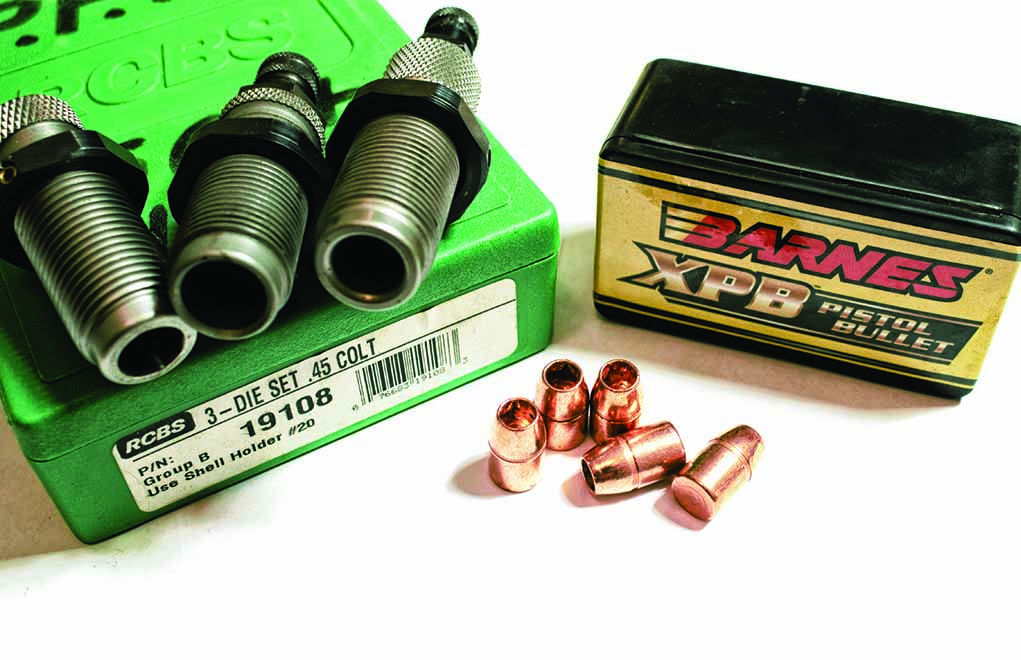
Using the same Hi-Tek Black bullet coating—which reduces friction and leading simultaneously—on a 250-grain, round-nose lead bullet, Choice Cowboy offers the classic formula for the .45 Colt, driving that bullet at a muzzle velocity of 820 fps for a combination suitable for all the various .45 Colt handguns. This load will work well for plinking, target shooting and hunting alike, although I’d want to limit it to deer-sized game. If you want the classic .45 Colt experience, this is it.
On the top end of the power spectrum, I really like the Choice .45 Colt +P “Bear Load,” driving a 325-grain Wide Flat Nose Gas Check hard-cast lead bullet that leaves my barrel at 1,305 fps. This load immediately lets you know it’s +P, because the muzzle jump is such that the unassuming shooter might lose their grip on the handgun. In other words: Hang on to it, or you’ll be picking up your revolver off the ground.
Generating 1,229 ft-lbs at the muzzle, this is surely a sound choice for a sidearm in bear country. I can keep five of these in a 4-inch group at 40 to 45 yards, and I like the authority with which this load speaks.
Want to use your .45 Colt for a defensive handgun? There’s nothing wrong with putting your faith in the Army’s old sweetheart. My Blackhawk likes the Winchester PDX1 Defender load (a 225-grain, bonded-core hollow-point at 850 fps—and it runs very close to the time-honored .45 ACP formula.
For the lead-free areas, or for those who simply enjoy the performance of monometal expanding bullets, look to the Barnes XPB bullets for a great option to take the .45 Colt hunting.
Is it as fast as the .44 Magnum? It gives up a little to Elmer Keith’s brainchild, but not much. Does the .45 Colt get shelved for the .454 Casull? Not in my opinion, because the heavier loads from Choice, Grizzly and Buffalo Bore are formidable for certain.
Even so, the affordability and diversity of ammo and gun choices give an advantage to the .45 Colt. Yes, the Casull can fire .45 Colt ammo, but the price of a Freedom Arms can be a real eye-opener.
The bottom line is this: Like the .45-70 Government, the .45 Colt remains relevant because the design was so good to begin with. Clearly, the .45 Colt isn’t going away anytime soon.
Editor's Note: This article originally appeared in the August 2020 issue of Gun Digest the Magazine.

Next Step: Get your FREE Printable Target Pack
Enhance your shooting precision with our 62 MOA Targets, perfect for rifles and handguns. Crafted in collaboration with Storm Tactical for accuracy and versatility.
Subscribe to the Gun Digest email newsletter and get your downloadable target pack sent straight to your inbox. Stay updated with the latest firearms info in the industry.

![Best Concealed Carry Guns In 2025 [Field Tested] Wilson Combat EDC X9S 1](https://gundigest.com/wp-content/uploads/Wilson-Combat-EDC-X9S-1-324x160.jpg)


![Best 9mm Carbine: Affordable PCCs [Tested] Ruger Carbine Shooting](https://gundigest.com/wp-content/uploads/Ruger-Carbine-Shooting-100x70.jpg)
![Best AR-15: Top Options Available Today [Field Tested] Harrington and Richardson PSA XM177E2 feature](https://gundigest.com/wp-content/uploads/Harrington-and-Richardson-PSA-XM177E2-feature-100x70.jpg)

Very Well written article, I could only add
1. the Ruger “Old” Vaquero, handles the heavy loads, but that darn squared off trigger guard really can be brutal on the knuckles.
2. rifle performance on the heavy loads approach 1500 ft/lbs ME and may be as high as 1000ft/lbs at 100 yards…about 1/3 of the power found with hot 45-70 rounds.
Yes not in the NEW VAQUERO or UBERTI or other copy 1873 pistols unless stated n the owners manuals. Cowboy loads only!
I don’t believe it’s accurate to call it “Long Colt.” Common error but not a good look on an article focusing on the .45 Colt as a good round, which it is.
Dang. Sorry. I reread the first paragraphs which I skipped through in my first read. My bad. My error. Where’s the dang delete feature!? Sorry.
I really enjoyed reading your thoughts on the 45 colt ammo and how it stands tall against challengers.
I truely enjoy running a few rounds through my Blackhawk.
I enjoyed it so much I got a Henry Big Boy in the 45 colt cal. And love running rounds through it.
Sadly though I’ve been limited to going to local ranges with 75 – 100 yd ranges. I guess I’m not
wording it right, cause I cant really find much info about the 45 colt round as a rifle round. Have even
had people tell me it is a pistol round and not much of a rifle round. I then proceed to inform them
how wrong they are, but I don’t have any longer range info to really back up what im saying.
Any additional info I’d appreciate it. Again thank you for your time. Robert